cooling FIAT 124 SPIDER 2018 Owner handbook (in English)
[x] Cancel search | Manufacturer: FIAT, Model Year: 2018, Model line: 124 SPIDER, Model: FIAT 124 SPIDER 2018Pages: 220, PDF Size: 3.18 MB
Page 34 of 220
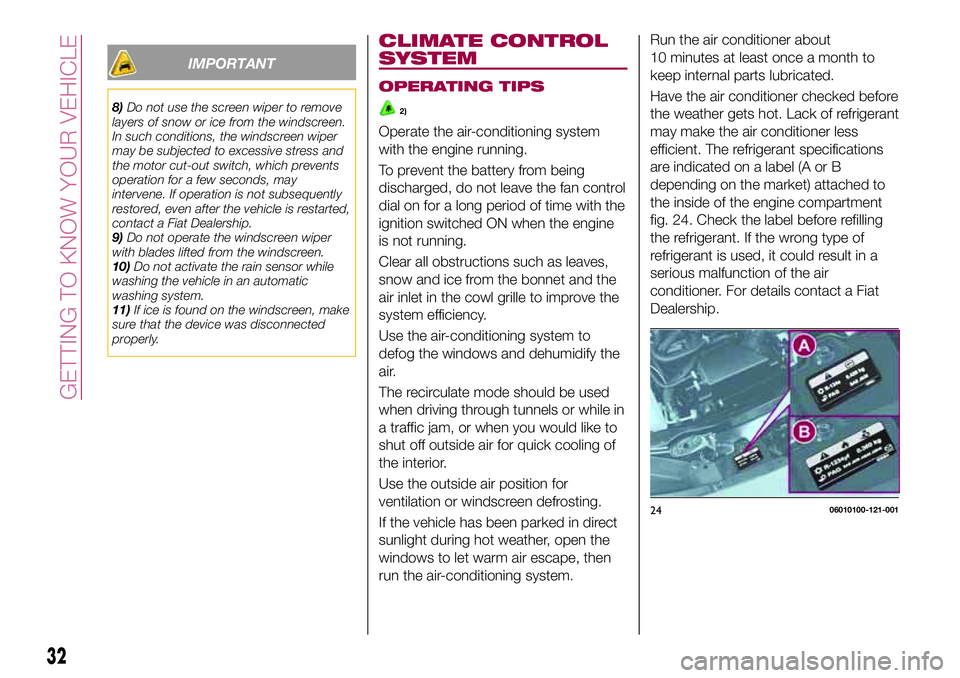
IMPORTANT
8)Do not use the screen wiper to remove
layers of snow or ice from the windscreen.
In such conditions, the windscreen wiper
may be subjected to excessive stress and
the motor cut-out switch, which prevents
operation for a few seconds, may
intervene. If operation is not subsequently
restored, even after the vehicle is restarted,
contact a Fiat Dealership.
9)Do not operate the windscreen wiper
with blades lifted from the windscreen.
10)Do not activate the rain sensor while
washing the vehicle in an automatic
washing system.
11)If ice is found on the windscreen, make
sure that the device was disconnected
properly.
CLIMATE CONTROL
SYSTEM
OPERATING TIPS
2)
Operate the air-conditioning system
with the engine running.
To prevent the battery from being
discharged, do not leave the fan control
dial on for a long period of time with the
ignition switched ON when the engine
is not running.
Clear all obstructions such as leaves,
snow and ice from the bonnet and the
air inlet in the cowl grille to improve the
system efficiency.
Use the air-conditioning system to
defog the windows and dehumidify the
air.
The recirculate mode should be used
when driving through tunnels or while in
a traffic jam, or when you would like to
shut off outside air for quick cooling of
the interior.
Use the outside air position for
ventilation or windscreen defrosting.
If the vehicle has been parked in direct
sunlight during hot weather, open the
windows to let warm air escape, then
run the air-conditioning system.Run the air conditioner about
10 minutes at least once a month to
keep internal parts lubricated.
Have the air conditioner checked before
the weather gets hot. Lack of refrigerant
may make the air conditioner less
efficient. The refrigerant specifications
are indicated on a label (A or B
depending on the market) attached to
the inside of the engine compartment
fig. 24. Check the label before refilling
the refrigerant. If the wrong type of
refrigerant is used, it could result in a
serious malfunction of the air
conditioner. For details contact a Fiat
Dealership.
2406010100-121-001
32
GETTING TO KNOW YOUR VEHICLE
Page 39 of 220
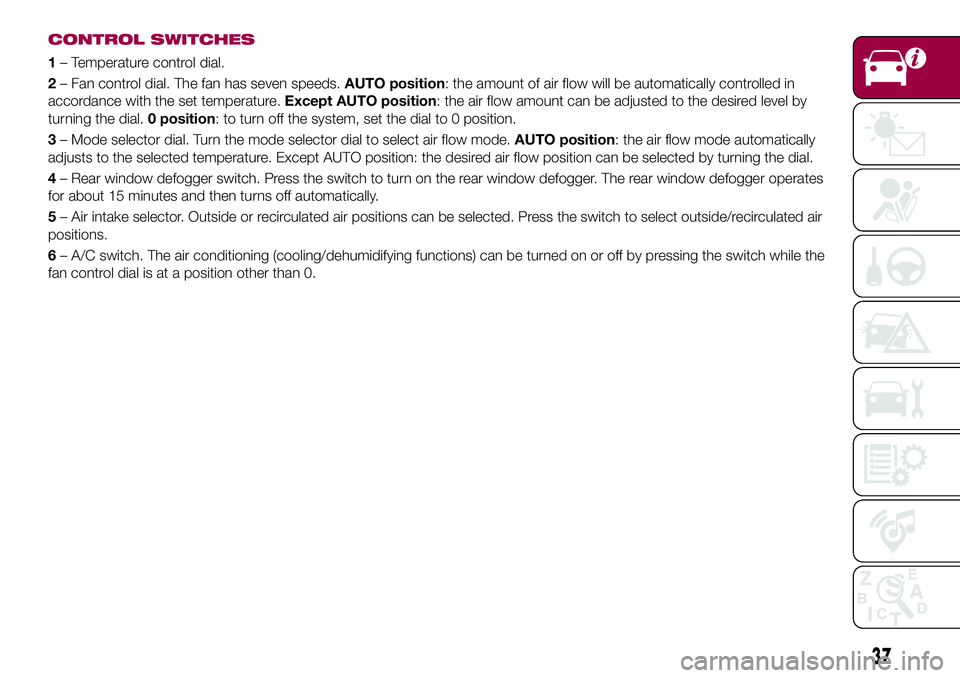
CONTROL SWITCHES
1– Temperature control dial.
2– Fan control dial. The fan has seven speeds.AUTO position: the amount of air flow will be automatically controlled in
accordance with the set temperature.Except AUTO position: the air flow amount can be adjusted to the desired level by
turning the dial.0 position: to turn off the system, set the dial to 0 position.
3– Mode selector dial. Turn the mode selector dial to select air flow mode.AUTO position: the air flow mode automatically
adjusts to the selected temperature. Except AUTO position: the desired air flow position can be selected by turning the dial.
4– Rear window defogger switch. Press the switch to turn on the rear window defogger. The rear window defogger operates
for about 15 minutes and then turns off automatically.
5– Air intake selector. Outside or recirculated air positions can be selected. Press the switch to select outside/recirculated air
positions.
6– A/C switch. The air conditioning (cooling/dehumidifying functions) can be turned on or off by pressing the switch while the
fan control dial is at a position other than 0.
37
Page 145 of 220
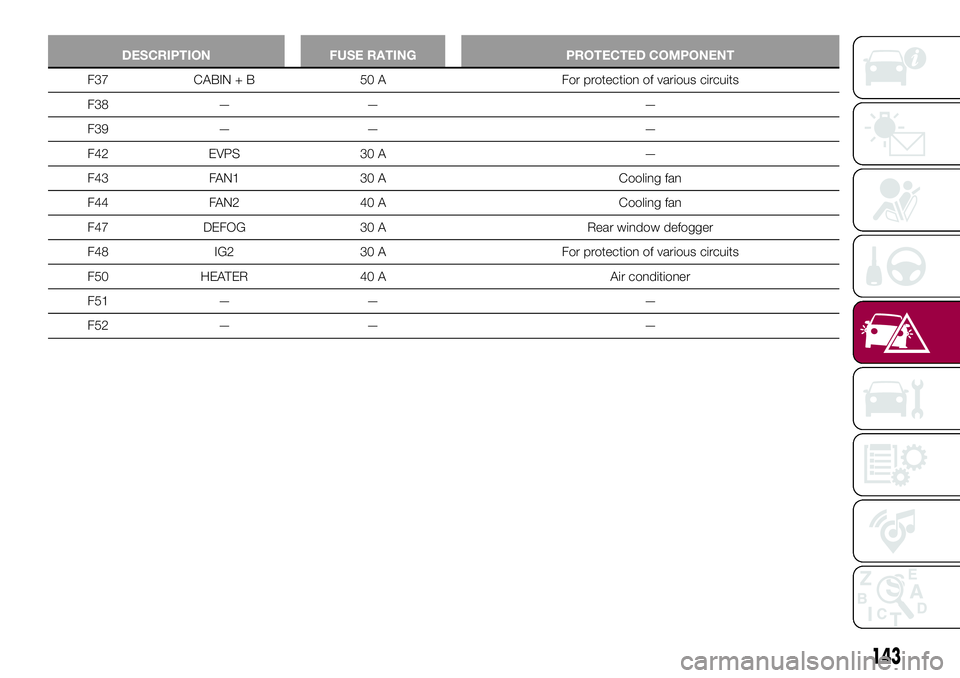
DESCRIPTION FUSE RATING PROTECTED COMPONENT
F37 CABIN + B 50 A For protection of various circuits
F38 — — —
F39 — — —
F42 EVPS 30 A —
F43 FAN1 30 A Cooling fan
F44 FAN2 40 A Cooling fan
F47 DEFOG 30 A Rear window defogger
F48 IG2 30 A For protection of various circuits
F50 HEATER 40 A Air conditioner
F51 — — —
F52 — — —
143
Page 154 of 220
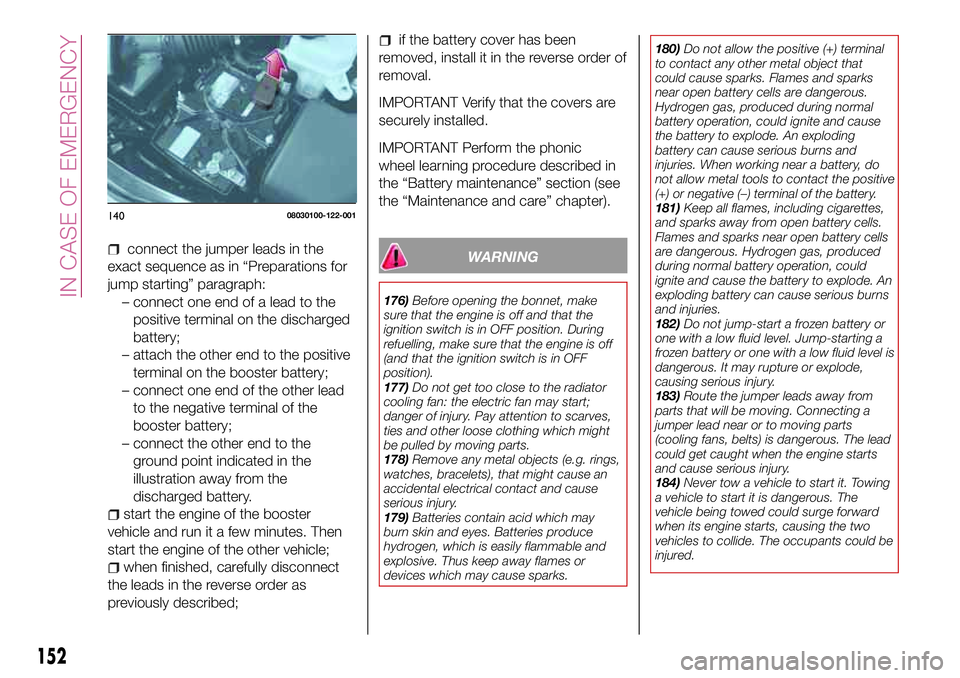
connect the jumper leads in the
exact sequence as in “Preparations for
jump starting” paragraph:
– connect one end of a lead to the
positive terminal on the discharged
battery;
– attach the other end to the positive
terminal on the booster battery;
– connect one end of the other lead
to the negative terminal of the
booster battery;
– connect the other end to the
ground point indicated in the
illustration away from the
discharged battery.
start the engine of the booster
vehicle and run it a few minutes. Then
start the engine of the other vehicle;
when finished, carefully disconnect
the leads in the reverse order as
previously described;
if the battery cover has been
removed, install it in the reverse order of
removal.
IMPORTANT Verify that the covers are
securely installed.
IMPORTANT Perform the phonic
wheel learning procedure described in
the “Battery maintenance” section (see
the “Maintenance and care” chapter).
WARNING
176)Before opening the bonnet, make
sure that the engine is off and that the
ignition switch is in OFF position. During
refuelling, make sure that the engine is off
(and that the ignition switch is in OFF
position).
177)Do not get too close to the radiator
cooling fan: the electric fan may start;
danger of injury. Pay attention to scarves,
ties and other loose clothing which might
be pulled by moving parts.
178)Remove any metal objects (e.g. rings,
watches, bracelets), that might cause an
accidental electrical contact and cause
serious injury.
179)Batteries contain acid which may
burn skin and eyes. Batteries produce
hydrogen, which is easily flammable and
explosive. Thus keep away flames or
devices which may cause sparks.180)Do not allow the positive (+) terminal
to contact any other metal object that
could cause sparks. Flames and sparks
near open battery cells are dangerous.
Hydrogen gas, produced during normal
battery operation, could ignite and cause
the battery to explode. An exploding
battery can cause serious burns and
injuries. When working near a battery, do
not allow metal tools to contact the positive
(+) or negative (–) terminal of the battery.
181)Keep all flames, including cigarettes,
and sparks away from open battery cells.
Flames and sparks near open battery cells
are dangerous. Hydrogen gas, produced
during normal battery operation, could
ignite and cause the battery to explode. An
exploding battery can cause serious burns
and injuries.
182)Do not jump-start a frozen battery or
one with a low fluid level. Jump-starting a
frozen battery or one with a low fluid level is
dangerous. It may rupture or explode,
causing serious injury.
183)Route the jumper leads away from
parts that will be moving. Connecting a
jumper lead near or to moving parts
(cooling fans, belts) is dangerous. The lead
could get caught when the engine starts
and cause serious injury.
184)Never tow a vehicle to start it. Towing
a vehicle to start it is dangerous. The
vehicle being towed could surge forward
when its engine starts, causing the two
vehicles to collide. The occupants could be
injured.
14008030100-122-001
152
IN CASE OF EMERGENCY
Page 164 of 220
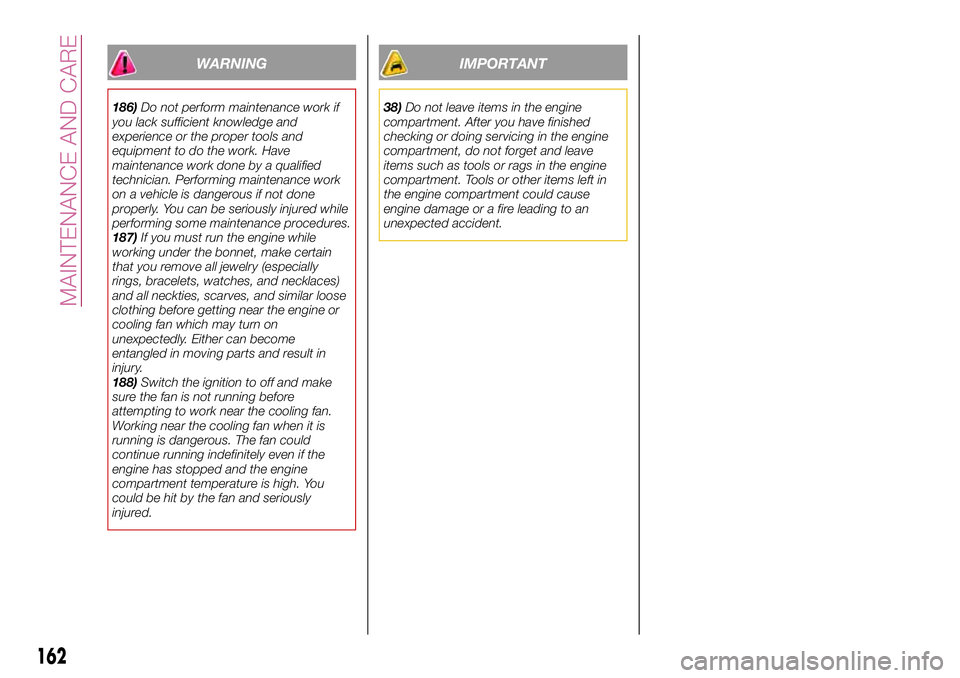
WARNING
186)Do not perform maintenance work if
you lack sufficient knowledge and
experience or the proper tools and
equipment to do the work. Have
maintenance work done by a qualified
technician. Performing maintenance work
on a vehicle is dangerous if not done
properly. You can be seriously injured while
performing some maintenance procedures.
187)If you must run the engine while
working under the bonnet, make certain
that you remove all jewelry (especially
rings, bracelets, watches, and necklaces)
and all neckties, scarves, and similar loose
clothing before getting near the engine or
cooling fan which may turn on
unexpectedly. Either can become
entangled in moving parts and result in
injury.
188)Switch the ignition to off and make
sure the fan is not running before
attempting to work near the cooling fan.
Working near the cooling fan when it is
running is dangerous. The fan could
continue running indefinitely even if the
engine has stopped and the engine
compartment temperature is high. You
could be hit by the fan and seriously
injured.
IMPORTANT
38)Do not leave items in the engine
compartment. After you have finished
checking or doing servicing in the engine
compartment, do not forget and leave
items such as tools or rags in the engine
compartment. Tools or other items left in
the engine compartment could cause
engine damage or a fire leading to an
unexpected accident.
162
MAINTENANCE AND CARE
Page 168 of 220
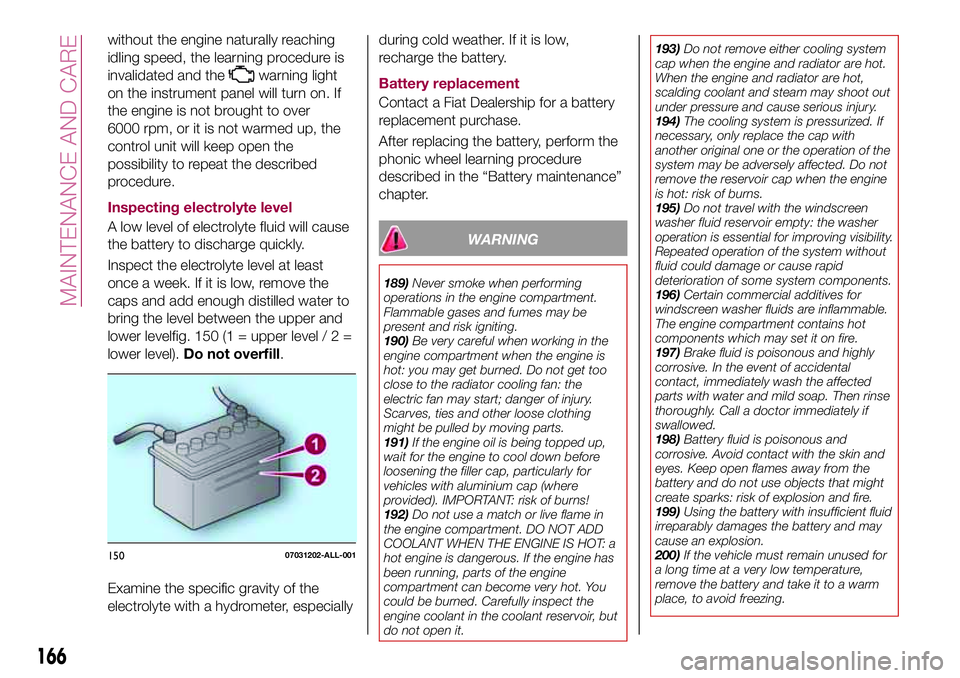
without the engine naturally reaching
idling speed, the learning procedure is
invalidated and the
warning light
on the instrument panel will turn on. If
the engine is not brought to over
6000 rpm, or it is not warmed up, the
control unit will keep open the
possibility to repeat the described
procedure.
Inspecting electrolyte level
A low level of electrolyte fluid will cause
the battery to discharge quickly.
Inspect the electrolyte level at least
once a week. If it is low, remove the
caps and add enough distilled water to
bring the level between the upper and
lower levelfig. 150 (1 = upper level/2=
lower level).Do not overfill.
Examine the specific gravity of the
electrolyte with a hydrometer, especiallyduring cold weather. If it is low,
recharge the battery.
Battery replacement
Contact a Fiat Dealership for a battery
replacement purchase.
After replacing the battery, perform the
phonic wheel learning procedure
described in the “Battery maintenance”
chapter.
WARNING
189)Never smoke when performing
operations in the engine compartment.
Flammable gases and fumes may be
present and risk igniting.
190)Be very careful when working in the
engine compartment when the engine is
hot: you may get burned. Do not get too
close to the radiator cooling fan: the
electric fan may start; danger of injury.
Scarves, ties and other loose clothing
might be pulled by moving parts.
191)If the engine oil is being topped up,
wait for the engine to cool down before
loosening the filler cap, particularly for
vehicles with aluminium cap (where
provided). IMPORTANT: risk of burns!
192)Do not use a match or live flame in
the engine compartment. DO NOT ADD
COOLANT WHEN THE ENGINE IS HOT: a
hot engine is dangerous. If the engine has
been running, parts of the engine
compartment can become very hot. You
could be burned. Carefully inspect the
engine coolant in the coolant reservoir, but
do not open it.193)Do not remove either cooling system
cap when the engine and radiator are hot.
When the engine and radiator are hot,
scalding coolant and steam may shoot out
under pressure and cause serious injury.
194)The cooling system is pressurized. If
necessary, only replace the cap with
another original one or the operation of the
system may be adversely affected. Do not
remove the reservoir cap when the engine
is hot: risk of burns.
195)Do not travel with the windscreen
washer fluid reservoir empty: the washer
operation is essential for improving visibility.
Repeated operation of the system without
fluid could damage or cause rapid
deterioration of some system components.
196)Certain commercial additives for
windscreen washer fluids are inflammable.
The engine compartment contains hot
components which may set it on fire.
197)Brake fluid is poisonous and highly
corrosive. In the event of accidental
contact, immediately wash the affected
parts with water and mild soap. Then rinse
thoroughly. Call a doctor immediately if
swallowed.
198)Battery fluid is poisonous and
corrosive. Avoid contact with the skin and
eyes. Keep open flames away from the
battery and do not use objects that might
create sparks: risk of explosion and fire.
199)Using the battery with insufficient fluid
irreparably damages the battery and may
cause an explosion.
200)If the vehicle must remain unused for
a long time at a very low temperature,
remove the battery and take it to a warm
place, to avoid freezing.
15007031202-ALL-001
166
MAINTENANCE AND CARE
Page 169 of 220
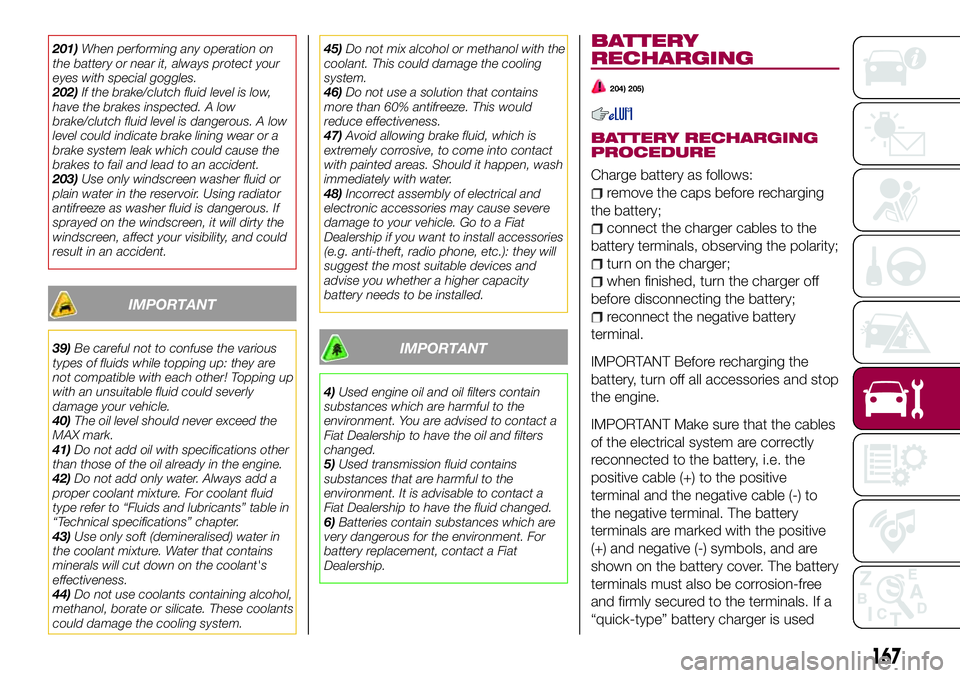
201)When performing any operation on
the battery or near it, always protect your
eyes with special goggles.
202)If the brake/clutch fluid level is low,
have the brakes inspected. A low
brake/clutch fluid level is dangerous. A low
level could indicate brake lining wear or a
brake system leak which could cause the
brakes to fail and lead to an accident.
203)Use only windscreen washer fluid or
plain water in the reservoir. Using radiator
antifreeze as washer fluid is dangerous. If
sprayed on the windscreen, it will dirty the
windscreen, affect your visibility, and could
result in an accident.
IMPORTANT
39)Be careful not to confuse the various
types of fluids while topping up: they are
not compatible with each other! Topping up
with an unsuitable fluid could severly
damage your vehicle.
40)The oil level should never exceed the
MAX mark.
41)Do not add oil with specifications other
than those of the oil already in the engine.
42)Do not add only water. Always add a
proper coolant mixture. For coolant fluid
type refer to “Fluids and lubricants” table in
“Technical specifications” chapter.
43)Use only soft (demineralised) water in
the coolant mixture. Water that contains
minerals will cut down on the coolant's
effectiveness.
44)Do not use coolants containing alcohol,
methanol, borate or silicate. These coolants
could damage the cooling system.45)Do not mix alcohol or methanol with the
coolant. This could damage the cooling
system.
46)Do not use a solution that contains
more than 60% antifreeze. This would
reduce effectiveness.
47)Avoid allowing brake fluid, which is
extremely corrosive, to come into contact
with painted areas. Should it happen, wash
immediately with water.
48)Incorrect assembly of electrical and
electronic accessories may cause severe
damage to your vehicle. Go to a Fiat
Dealership if you want to install accessories
(e.g. anti-theft, radio phone, etc.): they will
suggest the most suitable devices and
advise you whether a higher capacity
battery needs to be installed.IMPORTANT
4)Used engine oil and oil filters contain
substances which are harmful to the
environment. You are advised to contact a
Fiat Dealership to have the oil and filters
changed.
5)Used transmission fluid contains
substances that are harmful to the
environment. It is advisable to contact a
Fiat Dealership to have the fluid changed.
6)Batteries contain substances which are
very dangerous for the environment. For
battery replacement, contact a Fiat
Dealership.
BATTERY
RECHARGING
204) 205)
BATTERY RECHARGING
PROCEDURE
Charge battery as follows:
remove the caps before recharging
the battery;
connect the charger cables to the
battery terminals, observing the polarity;
turn on the charger;
when finished, turn the charger off
before disconnecting the battery;
reconnect the negative battery
terminal.
IMPORTANT Before recharging the
battery, turn off all accessories and stop
the engine.
IMPORTANT Make sure that the cables
of the electrical system are correctly
reconnected to the battery, i.e. the
positive cable (+) to the positive
terminal and the negative cable (-) to
the negative terminal. The battery
terminals are marked with the positive
(+) and negative (-) symbols, and are
shown on the battery cover. The battery
terminals must also be corrosion-free
and firmly secured to the terminals. If a
“quick-type” battery charger is used
167
Page 185 of 220
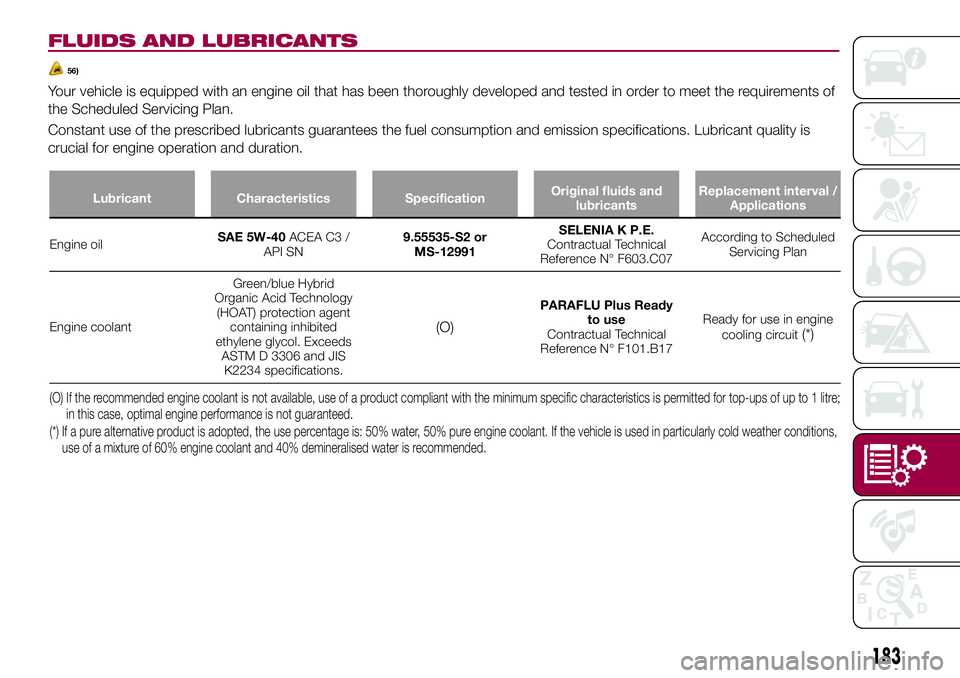
FLUIDS AND LUBRICANTS
56)
Your vehicle is equipped with an engine oil that has been thoroughly developed and tested in order to meet the requirements of
the Scheduled Servicing Plan.
Constant use of the prescribed lubricants guarantees the fuel consumption and emission specifications. Lubricant quality is
crucial for engine operation and duration.
183
Lubricant Characteristics SpecificationOriginal fluids and
lubricantsReplacement interval /
Applications
Engine oilSAE 5W-40ACEA C3 /
API SN9.55535-S2 or
MS-12991SELENIA K P.E.
Contractual Technical
Reference N° F603.C07According to Scheduled
Servicing Plan
Engine coolantGreen/blue Hybrid
Organic Acid Technology
(HOAT) protection agent
containing inhibited
ethylene glycol. Exceeds
ASTM D 3306 and JIS
K2234 specifications.
(O)
PARAFLU Plus Ready
to use
Contractual Technical
Reference N° F101.B17Ready for use in engine
cooling circuit
(*)
(O) If the recommended engine coolant is not available, use of a product compliant with the minimum specific characteristics is permitted for top-upsof up to 1 litre;
in this case, optimal engine performance is not guaranteed.
(*) If a pure alternative product is adopted, the use percentage is: 50% water, 50% pure engine coolant. If the vehicle is used in particularly cold weather conditions,
use of a mixture of 60% engine coolant and 40% demineralised water is recommended.